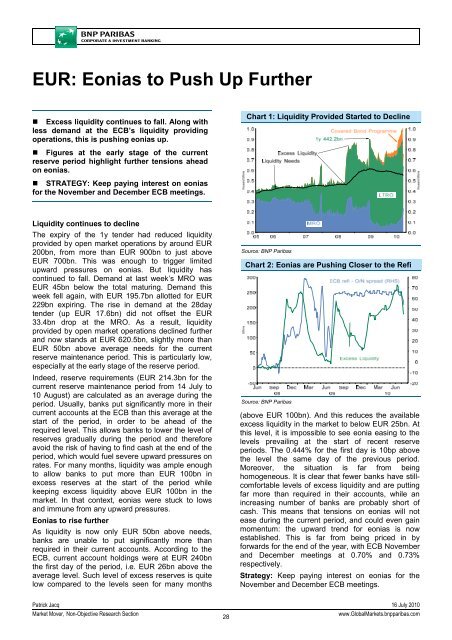Market Economics | Interest Rate Strategy - BNP PARIBAS ...
Market Economics | Interest Rate Strategy - BNP PARIBAS ...
Market Economics | Interest Rate Strategy - BNP PARIBAS ...
You also want an ePaper? Increase the reach of your titles
YUMPU automatically turns print PDFs into web optimized ePapers that Google loves.
EUR: Eonias to Push Up Further<br />
• Excess liquidity continues to fall. Along with<br />
less demand at the ECB’s liquidity providing<br />
operations, this is pushing eonias up.<br />
Chart 1: Liquidity Provided Started to Decline<br />
• Figures at the early stage of the current<br />
reserve period highlight further tensions ahead<br />
on eonias.<br />
• STRATEGY: Keep paying interest on eonias<br />
for the November and December ECB meetings.<br />
Liquidity continues to decline<br />
The expiry of the 1y tender had reduced liquidity<br />
provided by open market operations by around EUR<br />
200bn, from more than EUR 900bn to just above<br />
EUR 700bn. This was enough to trigger limited<br />
upward pressures on eonias. But liquidity has<br />
continued to fall. Demand at last week’s MRO was<br />
EUR 45bn below the total maturing. Demand this<br />
week fell again, with EUR 195.7bn allotted for EUR<br />
229bn expiring. The rise in demand at the 28day<br />
tender (up EUR 17.6bn) did not offset the EUR<br />
33.4bn drop at the MRO. As a result, liquidity<br />
provided by open market operations declined further<br />
and now stands at EUR 620.5bn, slightly more than<br />
EUR 50bn above average needs for the current<br />
reserve maintenance period. This is particularly low,<br />
especially at the early stage of the reserve period.<br />
Indeed, reserve requirements (EUR 214.3bn for the<br />
current reserve maintenance period from 14 July to<br />
10 August) are calculated as an average during the<br />
period. Usually, banks put significantly more in their<br />
current accounts at the ECB than this average at the<br />
start of the period, in order to be ahead of the<br />
required level. This allows banks to lower the level of<br />
reserves gradually during the period and therefore<br />
avoid the risk of having to find cash at the end of the<br />
period, which would fuel severe upward pressures on<br />
rates. For many months, liquidity was ample enough<br />
to allow banks to put more than EUR 100bn in<br />
excess reserves at the start of the period while<br />
keeping excess liquidity above EUR 100bn in the<br />
market. In that context, eonias were stuck to lows<br />
and immune from any upward pressures.<br />
Eonias to rise further<br />
As liquidity is now only EUR 50bn above needs,<br />
banks are unable to put significantly more than<br />
required in their current accounts. According to the<br />
ECB, current account holdings were at EUR 240bn<br />
the first day of the period, i.e. EUR 26bn above the<br />
average level. Such level of excess reserves is quite<br />
low compared to the levels seen for many months<br />
Source: <strong>BNP</strong> Paribas<br />
Chart 2: Eonias are Pushing Closer to the Refi<br />
Source: <strong>BNP</strong> Paribas<br />
(above EUR 100bn). And this reduces the available<br />
excess liquidity in the market to below EUR 25bn. At<br />
this level, it is impossible to see eonia easing to the<br />
levels prevailing at the start of recent reserve<br />
periods. The 0.444% for the first day is 10bp above<br />
the level the same day of the previous period.<br />
Moreover, the situation is far from being<br />
homogeneous. It is clear that fewer banks have stillcomfortable<br />
levels of excess liquidity and are putting<br />
far more than required in their accounts, while an<br />
increasing number of banks are probably short of<br />
cash. This means that tensions on eonias will not<br />
ease during the current period, and could even gain<br />
momentum: the upward trend for eonias is now<br />
established. This is far from being priced in by<br />
forwards for the end of the year, with ECB November<br />
and December meetings at 0.70% and 0.73%<br />
respectively.<br />
<strong>Strategy</strong>: Keep paying interest on eonias for the<br />
November and December ECB meetings.<br />
Patrick Jacq 16 July 2010<br />
<strong>Market</strong> Mover, Non-Objective Research Section<br />
28<br />
www.Global<strong>Market</strong>s.bnpparibas.com
















